.jpg)
Dear Members (a note from Deb Hickey):
I’ve always loved the sound of my father’s voice. Whether he was soothing me during an early morning thunderstorm as a child or helping me over the phone with my statistics homework during college, my dad’s voice has always comforted me.
Forty years later, I still call him when I’ve lost my way. The moment he picks up, my heart rate slows down. And as you’ve probably surmised, I also listen to his voice when we’re talking about protons and prostates about 15-20 times per week. Yet I never get tired of hearing him talk.
I’ve also heard from countless others that my father is a source of hope during times of despair. He seems to always have answers to seemingly impossible questions, and he has a special way of reassuring even the most nervous Nellie.
For the past year or so, I’ve been encouraging my father to produce an audio version of his book. Not only are audio books gaining in popularity, I think his personal and compelling writing style coupled with the compassionate sound of his voice could truly connect with many.
Fortunately, he finally agreed a couple of months ago. Of course, in his usual fashion, he then spent hours learning all he could about producing audio books. He researched producers, recording studios, as well as audiobook distributors. He was then finally ready to proceed.
I should mention – at one point, he considered hiring a professional narrator. “I’ve heard my voice on tape,” he said. “It’s pretty boring.”
I put my foot down. “There’s no way you’re going to have anyone other than you narrate your book.” I told him how my sister and I always loved the sound of his voice and reminded him how many times I’d heard from newly diagnosed men who told me that speaking with him relaxed them and gave them hope. “You’re not Paul Harvey or James Earl Jones, but you’re genuine and you have a very soothing voice.”
Once in a while, my dad takes my advice. And he did this time, too.
The whole project took about a month, and I think the final product is superb. He wrote about it in “The Book” section of this months’ BOB Tales. He also talks about distribution and availability.
This project gives me just one more reason to be proud of my father. I hope many of you get the opportunity to listen to the audio version of You Can Beat Prostate Cancer – And You Don’t Need Surgery to Do It. He included a link to an audio clip from the book in his write up, so you can get an idea of how it sounds.
-------------------
This month, we have some exciting news about the latest clinical trial results on the shortened (20-24) proton treatment protocol, called hypofractionation. We’ll also tell you why researchers think the multiparametric ultrasound may be a good alternative to the multiparametric MRI in some cases. We report on a new genetic screening tool that may predict a patient’s risk of developing metastatic prostate cancer or death. In our Flashback section, we go back 15 years when a Loma Linda University School of Health professor shared his theory on the health benefits of laughter. Later in our Health section, we continue our “How Not to Die” special series. This time we’re covering the No. 1 killer not only in the U.S., but also in most of the industrialized world – heart disease.
As always, we love to get feedback on the newsletter, and welcome any suggestions you have on how to improve the value of the BOB Tales to our members. Just send an email to [email protected].
Deb Hickey
To print the BOB Tales newsletter or view the newsletter with a larger font size, click here for the PDF file. .jpg)
.jpg)
In This Issue:
- Hypofractionated Proton Trials Show Excellent Results
- Specialized Ultrasound Can Accurately Detect Prostate Cancer
- New Screening Tool May Predict Risk of Developing Metastatic Prostate Cancer or Death
- Loma Linda Leads the Way with Protons, Transplants, Neonatal Care and … Laughter?
- How Not to Die from Heart Disease
- Low or No Meat Diet May Reduce Risk for Certain Cancers

.jpg)
Hypofractionated Proton Trials Show Excellent Results
The standard treatment protocol for administering proton therapy to patients with prostate cancer is roughly 1.6 to 2 Cobalt Gray (Gy) per dose for 38 to 44 treatments. Each proton center has its own standard treatment protocol and it may vary slightly from this range.
Hypofraction (HF) involves treating patients with higher doses in fewer fractions (treatments), typically 20 to 28 treatments. Patients in a study conducted at the University of Florida Health Proton Therapy Institute (UFHPTI) were treated with the same radiobiological equivalent (RBE) dose with HF as with the standard protocol. This means that, while the total dose, measured in Cobalt Gray, is typically lower with HF, the total effective dose is essentially the same as measured by RBE. In other words, the cancer-killing ability of the beam when delivered in somewhat higher doses in fewer fractions, can be the same as delivering lower doses over a larger number of fractions, even when the total dose as measured in Gy is different.
These HF clinical trials at UFHPTI have shown some excellent results as reported in Acta Oncologica and published in PubMed.gov and the National Library of Medicine.
A total of 582 patients were enrolled in the study which used double-scattered beam proton therapy between 2008 and 2015. The prostate cancer stages of patients in the study were 1) low-risk, 2) favorable intermediate risk, and 3) unfavorable intermediate risk. Some of the patients in the last category received androgen deprivation therapy (ADT), also called hormonal therapy, as part of their treatment.
The median follow-up was eight years. Freedom from disease progression was in the high 90 percentiles for most patients. Some of the unfavorable risk patients showed freedom from disease progression in the low 90 and high 80 percentiles.
Quality-of-life scores where genitourinary, gastrointestinal and bowel function results were measured, and were comparable to results for the standard treatment protocol.
Researchers concluded that image-guided, moderately accelerated hypofractionated proton therapy results “show high efficacy, minimal physician-assessed toxicity, and excellent patient-reported results.”
► BOB Comment: In our opinion, this moves us one-step closer to HF becoming the standard proton treatment protocol at some point in the near future. This means patients will be able to complete treatment in a much shorter time-period and expect a comparable result (excellent cure rates and minimal side effects) to today’s treatment protocol. We also suspect that when HF is implemented, costs will be lower and private insurers will be more likely to cover proton therapy without resistance.
Specialized Ultrasound Can Accurately Detect Prostate Cancer
The multiparametric MRI (mpMRI) has become the standard for prostate cancer detection, but it’s costly and can be time consuming. There are also patients who are physically incapable of completing the mpMRI scan due to contraindications such as pacemakers or claustrophobia.
London researchers say multiparametric ultrasound (mpUSS) for prostate cancer detection may be more cost effective and easily accessible than mpMRI.
To learn whether the mpUSS is as efffective as the mpMRI, researchers conducted a clinical trial of 370 men deemed at risk of prostate cancer. Each patient underwent both scans. After receiving positive results, 257 men underwent biopsies. Later, 133 were diagnosed with prostate cancer, 83 of which were considered clinically significant.
Researchers compared the positive scans to the confirmed cancers and found the mpUSS detected just 4.3 percent fewer clinically significant prostate cancers than the mpMRI. However the mpUSS findings resulted in 11.1 percent more patients being referred to biopsy.
Though the mpUSS detected prostate cancer at slightly lower rates than the mpMRI, experts believe ultrasound is a good alternative if mpMRI isn’t available. It’s also feasible that mpUSS could be used in low- and middle-income settings where access to expensive MRI equipment isn’t possible.
New Screening Tool May Predict Risk of Developing Metastatic Prostate Cancer or Death
A new screening tool that incorporates 290 inherited genetic variants associated with prostate cancer is able to accurately identify people with high versus low lifetime risks of developing metastatic prostate cancer or dying from the disease.
An expert in genitourinary cancers, Robert Dreicer, MD, MS, MACP, FASCO, said, “Current prostate cancer screening recommendations rely on family history as well as race and ethnicity factors which don’t fully capture a person’s risk of developing or dying from prostate cancer. This new study suggests that an extensive genetic risk score could be an effective tool to guide screening decisions by identifying people at high or low risk of developing metastatic prostate cancer. Importantly, this tool has been validated in a diverse population.”
“Heritable genetic information does not change over a person’s lifetime, whereas tumor gene expressions can be highly variable and are available only once a man has developed the disease. This algorithm was developed to predict the risk of prostate cancer at different ages,” said Meghana Pagadala, MD, PhD, the study’s lead author.
The researchers plan to study more ancestry-specific prostate cancer risk variants and hope to gain a better understanding of how to incorporate ancestry into estimating genetic risk. They also plan to analyze the interaction of genetic risk and environmental factors.

We’ve been producing BOB Tales newsletters for more than 20 years. During this time there have been articles that many new members haven’t seen, and some older members may have forgotten. So, we periodically re-run articles from past newsletters. The following is from more than 15 years ago, December 2006.
Loma Linda Leads the Way with Protons, Transplants, Neonatal Care and ... Laughter?
That’s right folks, laughter. On Nov. 19, Dr. Lee Berk was featured on a one-hour CNN special, called The Happiness Cure.
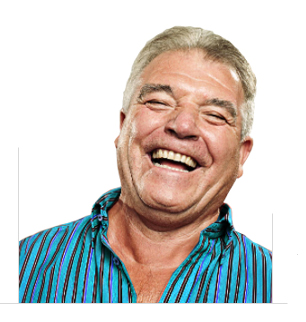 Dr. Berk is an associate professor of health promotion and education in the LLU School of Public Health and associate researcher professor of pathology and human anatomy in the LLU School of Medicine. He is an expert on the health benefits of laughter and has been studying laughter for many years (Why can’t I find a job like that?). The interview was conducted by CNN’s Sanjay Gupta and covered several aspects of laughter research – including how laughing improves health, the mind-body connection, and the nature of happiness.
Dr. Berk is an associate professor of health promotion and education in the LLU School of Public Health and associate researcher professor of pathology and human anatomy in the LLU School of Medicine. He is an expert on the health benefits of laughter and has been studying laughter for many years (Why can’t I find a job like that?). The interview was conducted by CNN’s Sanjay Gupta and covered several aspects of laughter research – including how laughing improves health, the mind-body connection, and the nature of happiness.
If you’re interested in the theory behind the benefits of laughter, Dr. Berk says,
Mirthful laughter – laughter arising from happiness instead of emotions such as embarrassment and anxiety – optimizes the activities of specific components of the neuroendocrine and immune systems and appears to offset physiological and mood states associated with the symptoms of chronic stress. Chronic stress can suppress immunity, especially antiviral and antitumor mechanisms such as natural killer cell activity.
During a humorous laughter event, there is an increase in the secretion of growth hormone, which optimizes immunity, and decreased secretion of adrenaline and cortisol, which suppress immunity.
Dr. Berk was interviewed in the 1980s for CBS’s 60 Minutes program and has done several other interviews on the Discovery Channel, the BBC, Australian Broadcasting Corp., Korean Broadcasting System and Canadian Broadcasting Corp.
When Dr. Berk and others first proposed their theory, people … well … laughed at it. But not any more. Laughter is linked with happiness, positive lifestyle and longevity. Benefits have been seen with maladies such as diabetes, cardiovascular disease, allergy, autoimmune disease, negative mood states and chronic stress.
Now we know why Carol Davis and Dr. Martell bring jokes to the Wednesday night meetings. Maybe we should place the “Lighter Side” humor section of this newsletter under “Health and Nutrition?”

Newsletter Feedback
Every now and then we feel compelled to share some of the newsletter feedback we receive. You won’t question why we decided to share these …
All I can say is “wow” because that’s a newsletter jam-packed full of chewy goodness.
-------------------
Your monthly newsletter looks like a ton of work! I don’t know how you do it, but I sure do appreciate it!
-------------------
People often refer to themselves as “a grateful member of _____” (fill in the blank). And so, I proclaim myself “a grateful member of the Brotherhood of the Balloon.”
-------------------
I am in awe of your organization and all that you do. Your monthly letter to members is worthy of great praise. You must have people working in the background on it – there’s no other explanation of how you produce such a masterpiece every four weeks. Is there sleep involved?
-------------------
My wife and I read every newsletter. I actually have all of them printed out and in a pile in my office. I never know when I’m going to have to access one – if someone needs advice on something. I particularly love the Health section.
-------------------
I appreciate the hard work and content in the BOB Tales. I’m especially interested in the good food choices to prevent cancer.

"Life on the Line"
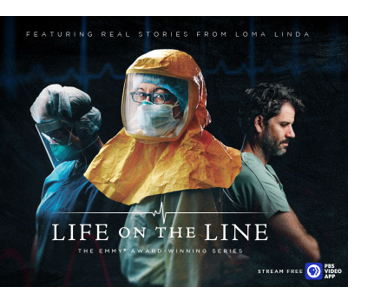 Loma Linda University Health serves one-quarter of California, and equips medical teams to travel around the world. LLUH’s national Emmy award-winning television show, Life on the Line follows patients from Southern California to the Amazon, Haiti and Egypt as they fight disease, face natural disasters, cope with disabilities, and battle mental illness.
Loma Linda University Health serves one-quarter of California, and equips medical teams to travel around the world. LLUH’s national Emmy award-winning television show, Life on the Line follows patients from Southern California to the Amazon, Haiti and Egypt as they fight disease, face natural disasters, cope with disabilities, and battle mental illness.
The latest season spotlights LLUH hospitals as they fight the coronavirus pandemic. Real people, doctors, and patients alike search for hope in the midst of COVID-19. In five 30-minute episodes, Life on the Line presents an inspiring view of the strength and spirit of these people and their stories.
“The serious situation we find ourselves in daily saps at our strength, but this season shows how our circumstances do not define our measure of hope and resilience,” says LLUH President Richard Hart, MD, DrPH. “The series team captured the shockwaves felt in the healthcare world in an impactful, inspiring way unique to other seasons of this show.”
Narrated by award-winning journalist Lisa Ling, each episode follows the experience of doctors and the patients they serve. Journey with a non-ICU doctor inundated with COVID-19 patients who tries to restore a pastor to his beloved congregation, an OB/GYN doctor on a mission to save an unborn baby and her mother, a burned-out ICU doctor fighting to stem the tide of coronavirus infections, a forensic pediatrician who unveils the ugly, hidden pandemic, and finally, a financial crisis that threatens to crush the hospital.
Give to LLUH’s COVID-19 Relief Fund.
Don't Just Stand There
In an effort to boost funding for basic and clinical proton therapy research on prostate cancer, pancreatic cancer, liver cancer, breast cancer, and more, we asked our members to donate $100 (or more) to Loma Linda University Cancer Center. In return, they’d receive an advance copy of Dr. William Preston’s book, Don’t Just Stand There – Realizing a Vision for Proton Therapy: Conversations with James M. Slater, MD, FACR. The response so far has been phenomenal. Thank you to all who’ve requested a copy.
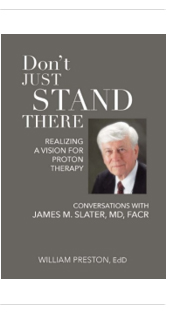 If you’d like a pre-published copy of “Don’t Just Stand There,” please send a check for $100 or more, payable to “Loma Linda University Proton Cancer Research” and mail it to:
If you’d like a pre-published copy of “Don’t Just Stand There,” please send a check for $100 or more, payable to “Loma Linda University Proton Cancer Research” and mail it to:
Loma Linda University Health ● Office of Philanthropy ● PO Box 2000 ● Loma Linda, CA 92354
Please notify Deb Hickey at [email protected] that you’ve sent in your check and your book will be mailed immediately.
Don’t Just Stand There, a book with high-quality color images and illustrations, is not just about Dr. Slater’s quest to create the world’s first hospital-based proton treatment center. It's also a teaching guide. As the Proton Treatment & Research Center at Loma Linda was such an immense endeavor, Dr. Slater wondered if the aspects of conceiving, planning, and orchestrating such a project, among others he undertook, might be instructive to others. Over the years, he’d also met people in all walks of life, many of whom had dealt with large and complex problems. He was struck by some of the stories they told about their work. And although the fields or disciplines usually had nothing to do with medicine, many experiences were similar. And so, he kept this in mind while he worked on the book with Dr. Preston.
We’re sure you’ll thoroughly enjoy the book and we know it will occupy a place of honor
in your home. And, you’ll be helping to fund basic and clinical proton research on prostate cancer, pancreatic cancer, liver cancer, breast cancer, and much more with your tax-deductible gift. Thank you!
Giving Options
- Donate to proton research online.
- Write a check to LLUCC Proton (Put “Marckini Chair” on the memo line) and mail to LLUH, Office of Philanthropy P.O. Box 2000, Loma Linda, CA 92354.
- Make an unrestricted gift (put “unrestricted” on memo line) so LLUH can use it where it’s needed most.
- Call Regina Joseph at 909-558-5010 to donate over the phone.
.jpg)
.jpg)

How Not to Die from Heart Disease
By Bob Marckini
Last month we told you about an important new book, How Not to Die, that was brought to our attention by our good friend, BOB member Charles Smithgall. “The book changed my life,” Charles said, by just about every measure.
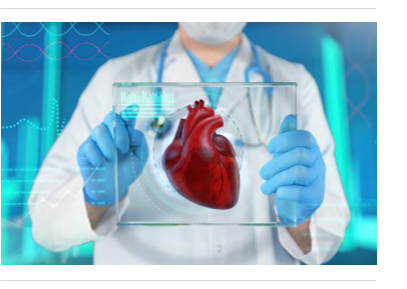 The author, Michael Greger, MD, is the founder of Nutritionfacts.org, a science-based nonprofit that follows and reports on the latest in nutrition research. In his book, Dr. Greger addresses the 15 leading causes of premature death that take the lives of 1.6 million Americans annually. And he says, “this doesn’t have to happen.”
The author, Michael Greger, MD, is the founder of Nutritionfacts.org, a science-based nonprofit that follows and reports on the latest in nutrition research. In his book, Dr. Greger addresses the 15 leading causes of premature death that take the lives of 1.6 million Americans annually. And he says, “this doesn’t have to happen.”
As we said last month: By reading Dr. Greger’s book, which is backed-up by a mountain of documented scientific evidence, you can learn about diet and lifestyle choices that can literally help you slow, stop, and even reverse diseases to live a longer and happier life.
Last month we covered the subject of “How Not to Die from Prostate Cancer.” This month we’re addressing the No. 1 killer in the U.S., heart disease.
Heart Disease in Perspective
Dr. Greger gets our attention by introducing this subject in a provocative way. He makes the argument, “Imagine if terrorists created a bioagent that spread mercilessly, claiming the lives of nearly 400,000 Americans every year. That is the equivalent of one person every 83 seconds, every hour, around the clock, year after year. We’d marshal the army and march our finest medical minds into a room to figure out a cure for this bioterror plague. In short, we’d stop at nothing until the terrorists were stopped.”
The fact is we are, in fact, losing that many Americans every year to a preventable threat, far less obvious than a biological agent, but every bit as lethal over time. The killer is fatty, atherosclerotic plaque deposits in the walls of your arteries caused primarily by the conventional American diet of meat, dairy, other animal products, processed foods, and junk food. The fatty deposits caused from eating these foods build up over decades, narrowing the path for blood flow, restricting blood circulation to the heart, leading to chest pain during exertion and often death.
Sadly, the first symptom of heart disease for many is cardiac death, because death can occur within an hour of symptom onset. Dr. Greger believes that the time to deal with cardiac disease is . . . before you have it.
There are countless studies – many reported in this newsletter in the past – which show societies that routinely consume a whole-foods, plant-based diet report minimal cardiovascular disease within their populations. Last month we reported on the Blue Zone studies that identified five places in the world where people are the healthiest and live the longest. Their diets, according to Dr. Greger, directly impact the No. 1 killer, heart disease, and he cites numerous studies that confirm this.
Heart disease is the No. 1 killer not only in the U.S., but also in most of the industrialized world. Yet, in rural China and in Central Africa, heart disease is practically non-existent. What do these two areas have in common? Their diets, in many respects, are quite different. But, the one thing they have in common is their diets are fundamentally centered on plant-derived foods, such as grains and vegetables. They eat a considerable amount of fiber and consume minimal animal fat. The author cites many more examples that support this theory.
Bottom line, he concludes that heart disease is not inevitable. It’s a choice. And, just as we should try to avoid sugary foods that rot our teeth, he says, “We can avoid the trans fat, saturated fat and cholesterol-laden foods that clog up our arteries.”
It’s Never Too Late
And it’s never too late to change your diet. Simple dietary changes at any age may help to prevent, stop and even reverse heart disease before it’s too late. Our diets begin to cause us problems even in childhood. Autopsies performed on young soldiers who were casualties of the Korean War, showed that 77 percent of them had coronary atherosclerosis. Autopsies performed on young children who died of accidental deaths also showed signs of early-stage atherosclerosis. These tend to develop into full-blown plaques by middle age and can begin killing us off.
The message here is you can, and should, begin to eat healthier at any age. And by doing so, you have a good chance of reversing heart disease you may not even know you have.
Cholesterol
The American Journal of Cardiology reports that cholesterol – especially LDL cholesterol – is the critical risk factor for plaque buildup in your blood. And the best way to reduce LDL cholesterol levels is to reduce your intake of trans fat, saturated fat, and dietary cholesterol. Trans fat comes from processed foods, meat, and dairy; saturated fat comes from animal products and junk food; and dietary cholesterol comes from various animal foods, especially eggs.
Dr. Greger is quick to point out that all three sources of cholesterol relate to animal products and “processed junk.” And this helps explain why societies that eat healthier plant-based diets largely remain free of cardiovascular disease.
Statins
Statin drugs help to reduce cholesterol, but they can come with certain side effects, including liver or muscle damage and an increased risk of breast cancer. Nevertheless, people who are unwilling to change their diets, can benefit from statins, even with the associated risks.
Heart Disease Can Be Reversed
The key takeaway from this chapter in How Not to Die, is that heart disease – the No. 1 killer – is reversable. As mentioned earlier, it’s never too late to begin eating healthfully. Studies by Nathan Pritikin, Dean Ornish and Caldwell Esselstyn on patients with advanced heart disease showed surprising results. Disease progression not only slowed, it actually reversed, as the artery-clogging plaque began to dissolve.
Dr. Greger tells us that “the best kept secret in medicine” is that, given the right conditions, the body heals itself. But – he points out – it cannot heal itself if it keeps getting abused over and over and over. “Within 15 years of stopping smoking, your lung cancer risk approaches that of a lifelong nonsmoker,” Greger tells us. So, by taking steps to change your diet to a heart-healthy plant-based diet, we can expect to slow, stop, and even reverse plaque buildup and heart disease in our own bodies.
There’s much more to this important first chapter in Dr. Greger’s book, including a whole section on endotoxins, which are bacterial toxins found in certain meats that harbor bacteria that can trigger inflammatory reaction in your arteries.
To make an important point, the author tells the story of a 65-year-old man with angina so severe, he had to stop every nine or 10 steps when walking. This same man, when put on a vegan diet reported pain relief within days. And, within months he was reportedly climbing mountains with no angina pain.
One Food That Can Help
Brazil nuts have been found to be as good as, or maybe even better than statins at bringing down cholesterol. Just a single serving of Brazil nuts can almost immediately reduce bad (LDL) cholesterol. Brazil nuts are “cheap, harmless and healthfully,” Greger says, but he recommends only about four servings per month since they are high in selenium.
Why Aren’t Doctors Promoting Healthful Diets?
While some doctors do discuss healthful diets with their patients, many do not. Most medical schools don’t require a single course on nutrition. Even worse, some mainstream medical organizations actually lobby against increased nutrition education for physicians. The author postulates that some of this may relate to food lobbies that have close associations with medical organizations and he provides several examples.
The tide may be turning, however. It wasn’t that many years ago when doctors were somewhat neutral about cigarette smoking. Today, most doctors have taken strong positions against smoking and are often seen leading the fight against tobacco. Smoking cessation has shown enormous benefits in slowing the epidemic of lung cancer in the U.S. Dr. Neal Barnard, president of The Physicians Committee for Responsible Medicine recently said, “Plant-based diets are the nutritional equivalent of quitting smoking.”
LLUH Ahead of the Curve
As mentioned in last month’s article on this book, Loma Linda University Health, a medical institution right in the heart (no pun intended) of one of the most prominent Blue Zones, has been promoting a whole-food plant-based diet, along with other important lifestyle practices, since their founding more than 100 years ago. I certainly witnessed their passion for diet and exercise when I was in treatment almost 22 years ago. Clearly, they have been ahead of the curve. Hopefully more doctors and medical centers will pay more attention to the critical importance of diet and lifestyle for preventing cardiovascular disease as advocates like Dr. Michael Greger speak out and provide data and a compelling argument on this subject.
I can remember my good friend, Dr. J. Lynn Martell saying at one of the Wednesday night meetings when I was in treatment, “Our proton treatment technology and staff will help you deal with your prostate cancer. But what are you going to do when you go home? If you go back to an unhealthy diet and sedentary lifestyle, you may be setting yourself up for cardiovascular disease or who knows what else.” Those words stuck with me and with many, many more of our members who were treated at LLUH. My wife and I made several changes when we returned home, and, thankfully, we’ve built on those healthful practices over the years.
Dr. Greger is right we have much more control over our health than we realize. Heart disease is the No. 1 killer in the U.S. and most of the industrialized world. We know what we must do to prevent this deadly disease or to slow, stop or reverse its progression.
The choice is ours.
Next Month
Next month we’ll be reviewing Chapter 6 from Dr. Greger’s landmark book, How Not to Die from diabetes.
► BOB Comment: You should not conclude from this book that a whole food plant-based diet fixes everything. Or, that the entire world needs to give up animal products to survive. But, certainly, reducing red meat and animal fats, while increasing your consumption of fruits and vegetables can help move you in the direction of a healthier life.
Low or No Meat Diet May Reduce Risk for Certain Cancers
Researchers at the University of Oxford conducted a prospective analysis of 472,377 UK participants to examine associations between vegetarian and non-vegetarian diets with cancer risk. The participants, who were all cancer-free at baseline, consisted of regular meat eaters (52.4 percent ate red meat or poultry five times or more per week), low meat eaters (43.5 percent ate red meat or poulrtry five times or less per week), fish-only eaters (2.3 percent) and vegetarian/vegans (1.8 percent).
After a mean follow-up of 11.4 years, 54,961 cases of cancer were detected among the participants. Of those, 5,882 participants were diagnosed with colorectal cancer, 7,537 women were diagnosed with breast cancer, and 9,501 men were diagnosed with prostate cancer.
The overall cancer risk declined in participants who consumed less meat. Risk was 2 percent lower among low meat eaters, 10 percent lower among fish-only eaters, and 14 percent lower among vegetarians and vegans compared with regular meat eaters.
Researchers also reported that those who ate meat less often had a 9 percent lower risk for colorectal cancer compared with regular meat eaters. In addition, the risk for prostate cancer was 20 percent lower among men who ate only fish and 31 percent lower among men who consumed a vegetarian or vegan diet compared with regular meat eaters.
► BOB Comment: This research certainly supports Michael Greger’s research in How Not to Die. We believe that limiting red and processed meat, and consuming a diet rich in vegetables, fruits, and whole grains is essential to living a long, healthful life.

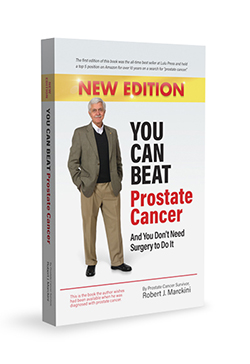 You Can Beat Prostate Cancer: And You Don’t Need Surgery to Do It –Second Edition
You Can Beat Prostate Cancer: And You Don’t Need Surgery to Do It –Second Edition
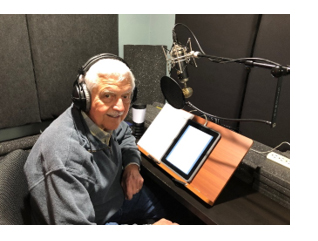 As Deb mentioned in the opening memo, Bob finally succumbed to the pressure and agreed to produce an audio version of his book. “Deb was one of many who strongly encouraged me to take the step,” Bob said. “And it was Deb who persuaded me to narrate it myself.”
As Deb mentioned in the opening memo, Bob finally succumbed to the pressure and agreed to produce an audio version of his book. “Deb was one of many who strongly encouraged me to take the step,” Bob said. “And it was Deb who persuaded me to narrate it myself.”
Photo left: Bob at Elephant Audiobooks recording studio in Arlington, MA
Audiobooks Are Becoming Mainstream
Written by Bob Marckini
In the process of preparing to create the audiobook, I learned that more than 45 percent of American adults have listened to audiobooks and that percentage is growing rapidly. Sales of non-fiction audiobooks represent one-third of all audiobooks sales in the U.S. and audiobook publications were up 40 percent last year.
Some people, including members of my own family, do essentially all their “reading” using audiobooks (Deb does!). Many have found audiobooks fit nicely into their busy schedules, as books downloaded to iPhones can easily be played over car radios wirelessly.
I was surprised to learn that audiobooks can also help enhance comprehension. This may not surprise those of you who know me, but when I decided to read How Not to Die, I purchased the hard cover book. After reading it, I listened to the audiobook. The book was packed with so much valuable information, I found myself learning much more by listening to the audio version later. It’s all a matter of personal preference, I suppose.
The Process
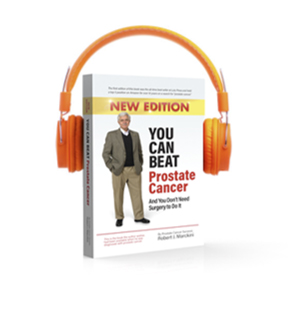 When producing an audiobook, you can either invest in the audio equipment, which connects to your computer or contract a recording studio and professionals to assist you with the process. I chose the latter. There are dozens of recording studios in Massachusetts, and most were booked months in advance. I chose Elephant Audiobooks in Arlington, MA, a small studio run by a young guy who really knows his stuff. It’s located two stories deep in the basement of a building in the center of town. Apparently it’s easier to block-out spurious noise if you’re underground.
When producing an audiobook, you can either invest in the audio equipment, which connects to your computer or contract a recording studio and professionals to assist you with the process. I chose the latter. There are dozens of recording studios in Massachusetts, and most were booked months in advance. I chose Elephant Audiobooks in Arlington, MA, a small studio run by a young guy who really knows his stuff. It’s located two stories deep in the basement of a building in the center of town. Apparently it’s easier to block-out spurious noise if you’re underground.
I must admit I found the process a bit intimidating at first: sitting in a soundproof studio with technicians outside the window watching wave patterns of my voice on three large monitors. Under those conditions, trying not to flub lines isn’t easy even when you’ve written them yourself. But after some time, I began to enjoy myself.
It took six recording sessions over a three-week period to complete the recording. The final product runs a little over 11 hours. And, while there are far better narrators out there, I’m pleased with the result. If you’d like to hear a five minute segment taken from the preface, click here.
Book Images
There are numerous charts, graphs, and illustrations in my book along with an important and extensive appendix. How best to convey this important information to listeners of my book? I turned to the resident expert on this subject in my family, my son-in-law, Deb’s husband, Mark Hickey, a brilliant graphic designer who created many of the images in the original book. Mark designed a website for me, www.youcanbeatprostatecancer.com, with a downloadable PDF file containing the images along with the book’s appendix. Now listeners have all the information that readers have access to.
Access For Non-Readers
I learned that a large number of adults simply won’t read print books, so if this new audio version gives access to these people, then I’m happy.
The audiobook is available on Amazon, Apple and iTunes. As soon as we complete arrangements with another distributor, it will also be available on 40 additional platforms including: Barnes & Noble, Nook, Walmart, Authors Direct, Ebsco, Hummingbird, audiobooks, Bidi, Google, and Rakuten.
Instructions for Listening on Your Smartphone
Listen to my audiobook on your iPhone by first downloading the free Audible App. To download our audiobook, go to Amazon.com. In the search bar, type in “You Can Beat Prostate Cancer.” Make sure it’s the New Edition with the gold bar on the front cover. Click on that book and you will see three options: 1) Kindle e-book version, 2) Audiobook and 3) Paperback. If you click on “Audiobook,” you can get it free with an Audible subscription, or, if you don’t have an Audible subscription, look to the right side of the page and you can click in the circle that says, “Buy with 1-Click.” The download takes about one minute. You can then listen to the audiobook with wireless earphones or on a Bluetooth remote speaker.
Early feedback has been overwhelmingly positive. I welcome your comments.
Step 6 in the 10 Steps
In October we began excerpting from, perhaps, the most important chapter in Bob’s second edition book, Chapter 18, titled, “Ten Steps for Taking Control of the Detection and Treatment of Your Prostate Cancer.” Step 1 was “Choose Your Doctors Wisely;” Step 2, “Have a PSA Test and DRE as Part of Your Annual Physical, And Track the Results.” Step 3 was “Have a Multi-parametric MRI Imaging if PSA is Rising.” Step 4. Manage Your Biopsy Test if Above Steps Lead to a Decision to Schedule a Biopsy. Following are excerpts from Step 5: Get a Second Opinion on Your Biopsy Results. Following are excerpts from Step 6:
Evaluate All Treatment Options – Including Active Surveillance
If you’re diagnosed with prostate cancer don’t rely on the first recommendation made by your urologist. Unless you’re too old or too weak to handle the trauma, he/she will most likely recommend surgery. Remember, urologists are surgeons, and for years, the “gold standard” for prostate cancer treatment has been surgery. Some of us have come to believe that surgery should be called “the old standard.” There are non-invasive treatment options that offer comparable cure rates without the trauma, blood loss, side effects, or recovery time of surgery.
Tip: Examine all the treatment options and choose the right one for you. Don’t let your physician make that decision for you.
Learn about the male anatomy and the location and function of the prostate. Learn everything you can about each of the treatment options you’re considering.
If you’re considering a radical prostatectomy, learn how the procedure is done. Evaluate all other non-invasive options before choosing surgery. Remember you are the one on the receiving end of the scalpel.
If your cancer stage is anything other than early stage, consider having a bone scan. This important test will help determine if the cancer has metastasized, i.e. traveled to distant parts of your body. Once you’ve ruled out metastasis, your options are many. Proton treatment was best for me. It may not be for you. Others have been successfully treated by the other options listed in earlier chapters.
Put together your own decision matrix. Assign the most weight to those factors which are most important to you. Perhaps taking time away from family and work isn’t feasible. This could rule out proton treatment – unless you live near one of the treatment centers and can continue your normal work routine while in treatment.
Perhaps the minimal hospital stay of brachytherapy, combined with quick recovery, is most important to you, even if certain side effects have a higher probability of occurring. Or perhaps you may feel strongly about having the gland with the cancer removed from your body as soon as possible, and thus prefer the oldest method, surgery
Most newly diagnosed patients have relatively early-stage disease, which means you don’t have to rush into treatment. You have time to do your due diligence and you owe it to yourself to learn about all the treatment options.
I’ve spoken with many men who regretted their treatment decision and wished they had done more homework when they were first diagnosed. If you’re reading this book, you’re doing just that.
NCCN Prostate Cancer Treatment Guidelines
The National Comprehensive Care Network (NCCN) is a highly respected association of 21 cancer treatment centers. Their treatment guidelines should be considered – not blindly followed – when making a treatment decision. The following NCCN guidelines are adapted from Mohler J, et al. NCCN Clinical Practice Guidelines in Oncology: Prostate Cancer. Journal of NCCN. 2010;8:162-200.43:
Risk Group: Very Low
- Stage T1c
- PSA less than 10 ng/mL
- Gleason score 6 or less and not more than two cores with cancer
- Less than 50 percent of core involved with cancer
- PSA density less than 0.15
Newly diagnosed cases: 15 percent
NCCN recommendation:
- Active surveillance when life expectancy is fewer than 20 years.
Risk Group: Low
- Stage T1c or T2a and
- PSA less than 10 ng/mL and
- Gleason score less than 6
Newly diagnosed cases: About 35 percent
NCCN recommendation:
- Active surveillance when life expectancy is fewer than 10 years.
- Active surveillance, surgery or radiation when life expectancy is more than 10 years.
Risk Group: Intermediate
- Stage T2b-T2c or
- PSA 10 to 20 ng/mL or
- Gleason score 7
Newly diagnosed cases: About 40 percent
NCCN recommendation:
- Active surveillance or external radiation with/without hormonal therapy, with/without brachytherapy or surgery if life expectancy is fewer than 10 years.
- Surgery or external radiation with/without hormonal therapy, with/without brachytherapy if life expectancy is 10 or more years.
Risk Group: High
- Stage T3a or
- PSA 20 ng/mL or higher or
- Gleason score 8 or higher
Newly diagnosed cases: About 10 percent
NCCN recommendation:
- Surgery or radiation plus hormonal therapy.
Did you find Bob’s new book helpful?
Please write a review on Amazon! The more reviews, the more likely a user will purchase a product. Every single review contributes to the visibility of this book.
So many urologists and family providers aren’t informed about proton therapy and most mainstream media discount proton therapy as a viable treatment option. We’re fighting daily for this to change! One way is through the book that helped so many of you learn about proton therapy for prostate cancer. Please help others find it.
We’re happy to discount books in quantity (minimum 20) to anyone interested in spreading the word on proton therapy. Just send an email to Deb Hickey. Proceeds from book sales are used to help fund our efforts and to support proton therapy research.
The Kindle version is free to Kindle Unlimited members or can be purchased for $9.99 for non-members. The paperback price is $22.45. Buy You Can Beat Prostate Cancer second edition on Amazon or Lulu Press.

National Proton Conference
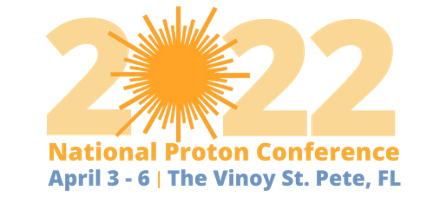 The National Association for Proton Therapy (NAPT) will be holding its next annual conference in St. Petersburg, FL, April 3-6, 2022. There will be two full days of in-person engagement, education, and collaboration among experts in the proton therapy world.
The National Association for Proton Therapy (NAPT) will be holding its next annual conference in St. Petersburg, FL, April 3-6, 2022. There will be two full days of in-person engagement, education, and collaboration among experts in the proton therapy world.
Exhibits: There are typically large halls filled with exhibits showing the latest developments in proton therapy technology, equipment, systems, and support systems. Information is presented on new particle accelerator design, new beam delivery systems, more precise control systems, and many things connected with proton therapy.
Attendance: Proton therapy centers from all over the world send representatives to the conference. Often clinicians and clinical leaders from all the major U.S. proton centers are in attendance, and many participate in panel discussions. Other attendees include physicists, senior administrative officials, and vendors who design and make equipment, products, and systems that support proton therapy and related technologies.
Panels and Presentations: Several presenters and panels will address a variety of proton-related issues ranging from the latest developments in proton therapy research, clinical and technological advances in proton therapy, global proton initiatives, and the economics and sustainability of proton center development and growth.



Last Month’s Brain Teaser
We introduced this teaser as one for our lateral thinking members …
Rearrange the following group of letters to form a single word:
S N E W G A L R D O I
Answer (Are you ready for this?): A single word
Winner: In contrast to last month when we were inundated with brain teaser responses, we received very few guesses on the March teaser. And interestingly, half of the respondents answered with “girandoles.” This is a great guess, but there’s no “w” in girandoles. ;)
The winner is Robert Ferre of San Antonio, TX. Robert was treated with proton therapy at Provision CARES Proton Therapy in Knoxville, TN in 2016. Since then he’s created his own website and written two books about his experience.
Congratulations, Robert! Your signed copy of Bob Marckini’s book is on its way…
.jpg)
.jpg)
New Brain Teaser
This one’s for the engineers and scientists in our group …
The moon is about a quarter million miles from Earth. If a large meteor crashed into the moon, how long would it take for the sound of the explosion to reach the Earth?
Send your brain teaser answer to [email protected] for a chance to win a signed copy of Bob Marckini’s NEW second edition book, You Can Beat Prostate Cancer.
Random Thoughts
The ability to speak several languages is an asset, but the ability to keep your mouth shut in any language is priceless.
Boss: “The starting pay is $40,000. Later it can go up to $80,000.”
Prospective employee: “Great, I’ll start later.”
Only in math problems can you buy 60 cantaloupes, and no one asks what is wrong with you.
Just once, I want the username and password prompt to say, “close enough.”
Becoming an adult is the dumbest thing I’ve ever done.
Did you hear about the restaurant on the moon? Great food, but no atmosphere.
If you see me talking to myself just move along. I’m self-employed, and we’re having a meeting.
Does anyone else have a plastic bag full of plastic bags, or is it just me?
Today’s 3-year-olds can switch on laptops and open their favorite apps. When I was three, I ate mud.
Tip for a successful marriage: Don’t ask your wife when dinner will be ready while she’s mowing the lawn.
So, you drive across town to a gym to walk on a treadmill?
Learning the Language
One of our members has a good friend who immigrated to the U.S. from India. He sent a few comments about his difficulty in learning our language:
- English is the only language where you drive in parkways and park in driveways.
- It’s also the only language where you recite in a play and play in a recital.
- The word “queue” is just a Q followed by four silent letters!
- Jail and prison are synonyms. But jailer and prisoner are antonyms.
- Your fingers have fingertips, but your toes don’t have toe tips. Also, you can tiptoe, but you can’t tipfinger.
- When you transport something by car, it’s called a shipment. But when you transport something by ship, it’s called cargo.
“Now, maybe you can understand why I’m having difficulty learning your language,” he said.


Estate Planning Hints
BOB Member Ron Hendricks is Director, US Foundation for Trinity Western University. He regularly copies us on his “News from Ron” mailings, which are helpful hints on estate planning to the readers of his newsletters. We have found Ron’s suggestions to be timely and beneficial. With his permission we periodically share some of his wisdom with our membership. This excerpted segment is called …
What Does Power of Attorney Mean and Why Do I Need One?
Power of Attorney for Healthcare
A Durable Power of Attorney for Healthcare empowers another person you select to make key decisions regarding your care. These could include whether a particular surgery should be done, or other major healthcare decisions should be made. It is important to ensure that the right person has been selected. It is called a “durable” power because it is effective even if you are ill and not capable of making your own decisions.
Power of Attorney for Finances
A common concern is, “What if I am sick and am no longer able to manage my property?” Unfortunately, there are far too many cases in which the property of senior persons is mismanaged or taken away by fraud or misrepresentation. A very good plan to protect yourself and your property is to have a durable power of attorney for finances. If you are no longer able to manage your property or later wish to have someone else manage your property, this durable power of attorney will give the person you select the legal authority to buy, sell and manage your property. The durable power of attorney enables the individual you designate to manage your property and provide for your care.
Boy, Were They Wrong—Part II! (Source)
“Heavier-than-air flying machines are impossible.” ─Lord Kelvin (1824-1907), ca. 1895, British mathematician and physicist
“Space travel is utter bilge.” ─Dr. Richard van der Reit Wooley, Astronomer Royal, space advisor to the British government, 1956. (Sputnik orbited the earth the following year.)
“Computers in the future may perhaps weigh only 1.5 tons.” ─Popular Mechanics, 1949.
“There is no reason for any individual to have a computer in their home.” ─Kenneth Olsen, president and founder of Digital Equipment Corp., 1977.
“I think there is a world market for maybe five computers.” ─Thomas Watson, chairman of IBM, 1943
“We don’t like their sound, and guitar music is on the way out.” ─Decca Recording Company on declining to sign the Beatles, 1962
“Television won’t last because people will soon get tired of staring at a plywood box every night.” ─Darryl Zanuck, movie producer, 20th Century Fox, 1946
Strange but True Facts (Source)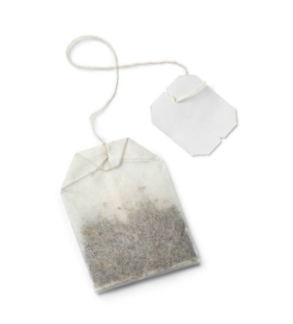
The tea bag was an accidental invention.
In 1908, New York tea merchant Thomas Sullivan sent samples of tea leaves to some of his customers in small silken bags. Many of the recipients assumed that the bags were supposed to be used in the same way as the metal infusers. So, they put the entire bag into the teapot, rather than emptying out its contents.
After such positive feedback from the happy accident, Sullivan designed intentional teabags for commercial production. In the 1920s, his sachets made of gauze—and later, paper—included the string with the tag hanging over the side so the bag could be easily removed. Some things really do stay the same.
Paper bags can be worse for the environment than plastic ones.
It’s become a common notion that paper is always a better choice than plastic. In fact, bans on plastic bags are regularly being enacted.
However, both paper and plastic have their drawbacks. According to research, paper bag production emits 70 percent more pollution, uses four times as much energy, and takes more time to break down, when compared to plastic bags. Guess the best option is to carry reusable bags with you.
Bubble wrap was originally intended to be wallpaper.
Bubble wrap was invented in 1957 by engineers Alfred W. Fielding and Marc Chavannes, who sealed two shower curtains together, creating a smattering of air bubbles, which they initially tried to sell as wallpaper. Then, in 1960, they realized their product could be used for protection in packaging, and they founded Sealed Air Corporation. When the inventors showed the product to IBM, which had just launched its first mass-produced computers, the tech company became the first big bubble wrap client. Sealed Air still exists today, creating both Cryovac® food packaging and yes, bubble wrap.
.jpg)
.jpg)
Quote of the Month:
“When you arise in the morning, give thanks for the morning light, for your life and strength. Give thanks for your food, and the joy of living. If you see no reason for giving thanks, the fault lies with yourself.”
– Tecumseh, Shawnee Chief



The Train of Life (Source)
The following was sent to us by one of our members. It’s listed as author unknown. But some research shows it may have come from the poem, “Life is Like a Train Ride” by John Passaro.
At birth, we board the train and meet our parents, and we believe they will always travel by our side.
As time goes by, other people will board the train; and they will be significant, i.e. our siblings, friends, children, and even the love of our life.
However, at some station our parents will step down from the train, leaving us on the journey alone.
Others will step down over time and leave a permanent vacuum.
Some, however, will go so unnoticed that we don’t realize they vacated their seats.
The train ride will be full of joy, sorrow, fantasy, expectations, hellos, goodbyes, and farewells.
Success consists of having a good relationship with all passengers requiring that we give the best of ourselves.
The mystery to everyone is: We don’t know at which station we will step down.
So, we must live in the best way: love, forgive, and offer the best of who we are.
It’s important to do this because when the time comes for us to step down and leave our seat empty, we should leave behind beautiful memories for those who will continue to travel on the train of life.
I wish you all a joyful journey.
Low PSAs to all,
Bob Marckini and Deb Hickey
To print the BOB Tales newsletter or view the newsletter with a larger font size, click here for the PDF file.
NO MEDICAL ADVICE: Material appearing here represents opinions offered by non-medically-trained laypersons. Comments shown here should NEVER be interpreted as specific medical advice and must be used only as background information when consulting with a qualified medical professional.
